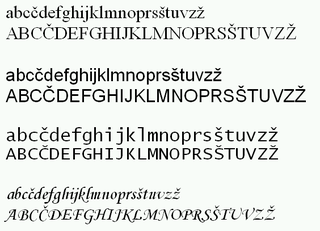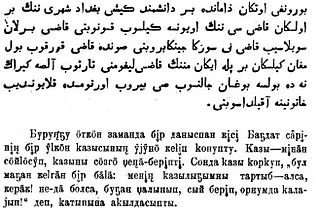Related Research Articles

An alphabet is a standard set of letters written to represent particular sounds in a spoken language. Specifically, letters correspond to phonemes, the categories of sounds that can distinguish one word from another in a given language. Not all writing systems represent language in this way: a syllabary assigns symbols to spoken syllables, while logographies assign symbols to words, morphemes, or other semantic units.

Character encoding is the process of assigning numbers to graphical characters, especially the written characters of human language, allowing them to be stored, transmitted, and transformed using digital computers. The numerical values that make up a character encoding are known as "code points" and collectively comprise a "code space", a "code page", or a "character map".

The Cyrillic script, Slavonic script or simply Slavic script is a writing system used for various languages across Eurasia. It is the designated national script in various Slavic, Turkic, Mongolic, Uralic, Caucasian and Iranic-speaking countries in Southeastern Europe, Eastern Europe, the Caucasus, Central Asia, North Asia, and East Asia, and used by many other minority languages.
ISO/IEC 8859 is a joint ISO and IEC series of standards for 8-bit character encodings. The series of standards consists of numbered parts, such as ISO/IEC 8859-1, ISO/IEC 8859-2, etc. There are 15 parts, excluding the abandoned ISO/IEC 8859-12. The ISO working group maintaining this series of standards has been disbanded.
The ogonek is a diacritic hook placed under the lower right corner of a vowel in the Latin alphabet used in several European languages, and directly under a vowel in several Native American languages. It is also placed on the lower right corner of consonants in some Latin transcriptions of various indigenous languages of the Caucasus mountains.
The double acute accent is a diacritic mark of the Latin and Cyrillic scripts. It is used primarily in Hungarian or Chuvash, and consequently it is sometimes referred to by typographers as hungarumlaut. The signs formed with a regular umlaut are letters in their own right in the Hungarian alphabet—for instance, they are separate letters for the purpose of collation. Letters with the double acute, however, are considered variants of their equivalents with the umlaut, being thought of as having both an umlaut and an acute accent.

Mojibake is the garbled or gibberish text that is the result of text being decoded using an unintended character encoding. The result is a systematic replacement of symbols with completely unrelated ones, often from a different writing system.
A caron is a diacritic mark commonly placed over certain letters in the orthography of some languages to indicate a change of the related letter's pronunciation.

The Slovene alphabet is an extension of the Latin script used to write Slovene. The standard language uses a Latin alphabet which is a slight modification of the Croatian Gaj's Latin alphabet, consisting of 25 lower- and upper-case letters:
Alphabetical order is a system whereby character strings are placed in order based on the position of the characters in the conventional ordering of an alphabet. It is one of the methods of collation. In mathematics, a lexicographical order is the generalization of the alphabetical order to other data types, such as sequences of numbers or other ordered mathematical objects.
The Unicode collation algorithm (UCA) is an algorithm defined in Unicode Technical Report #10, which is a customizable method to produce binary keys from strings representing text in any writing system and language that can be represented with Unicode. These keys can then be efficiently compared byte by byte in order to collate or sort them according to the rules of the language, with options for ignoring case, accents, etc.

Gaj's Latin alphabet, also known as abeceda or gajica, is the form of the Latin script used for writing Serbo-Croatian and all of its standard varieties: Bosnian, Croatian, Montenegrin, and Serbian.

Three alphabets are used to write Kazakh: the Cyrillic, Latin and Arabic scripts. The Cyrillic script is used in Kazakhstan and Mongolia. An October 2017 Presidential Decree in Kazakhstan ordered that the transition from Cyrillic to a Latin script be completed by 2031. The Arabic script is used in Saudi Arabia, Iran, Afghanistan, and parts of China.

The Latin script, also known as the Roman script, and technically Latin writing system is an alphabetic writing system based on the letters of the classical Latin alphabet, derived from a form of the Greek alphabet which was in use in the ancient Greek city of Cumae, in southern Italy. The Greek alphabet was altered by the Etruscans, and subsequently their alphabet was altered by the Romans. Several Latin-script alphabets exist, which differ in graphemes, collation and phonetic values from the classical Latin alphabet.
Unicode equivalence is the specification by the Unicode character encoding standard that some sequences of code points represent essentially the same character. This feature was introduced in the standard to allow compatibility with preexisting standard character sets, which often included similar or identical characters.
ISO/IEC 14651:2016, Information technology -- International string ordering and comparison -- Method for comparing character strings and description of the common template tailorable ordering, is an International Organization for Standardization (ISO)/International Electrotechnical Commission (IEC) standard specifying an algorithm that can be used when comparing two strings. This comparison can be used when collating a set of strings. The standard also specifies a datafile specifying the comparison order, the Common Tailorable Template, CTT. The comparison order is supposed to be tailored for different languages, since different languages have incompatible ordering requirements. One such tailoring is European ordering rules (EOR), which in turn is supposed to be tailored for different European languages.
The ISO basic Latin alphabet is an international standard for a Latin-script alphabet that consists of two sets of 26 letters, codified in various national and international standards and used widely in international communication. They are the same letters that comprise the current English alphabet. Since medieval times, they are also the same letters of the modern Latin alphabet. The order is also important for sorting words into alphabetical order.
The Universal Coded Character Set is a standard set of characters defined by the international standard ISO/IEC 10646, Information technology — Universal Coded Character Set (UCS), which is the basis of many character encodings, improving as characters from previously unrepresented typing systems are added.
A Latin-script alphabet is an alphabet that uses letters of the Latin script. The 21-letter archaic Latin alphabet and the 23-letter classical Latin alphabet belong to the oldest of this group. The 26-letter modern Latin alphabet is the newest of this group.
References
- Notes
- Hansson, Roger; Lindgren, Carl Göran; Ljung, Heléne; Lundén, Thomas. Språk och skrift i Europa. SNS Förlag. (2004) ISBN 91-7150-936-4
- Küster, Marc Wilhelm: Geordnetes Weltbild. Die Tradition des alphabetischen Sortierens von der Keilschrift bis zur EDV. Eine Kulturgeschichte. Niemeyer (2006) ISBN 3-484-10899-1. Written by the editor of ENV 13710, it discusses in chapter 17.4 the genesis and the contents of the EOR. Cf. also , in particular also